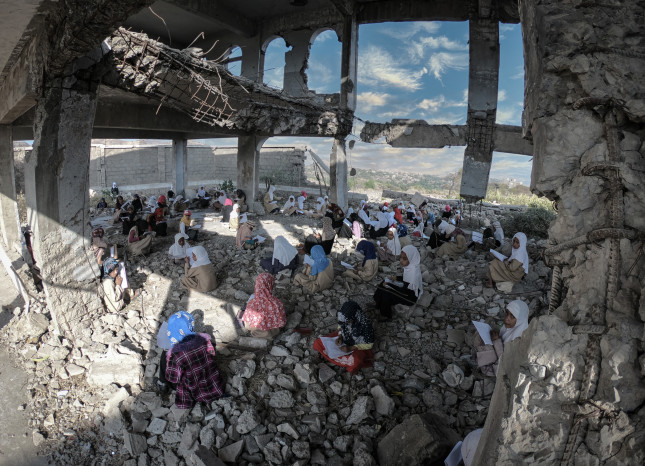-
The Changing Face of the Global Humanitarian Crisis: Gender, Climate Change, and Humanitarian Interventions
December 13, 2021 By Shruti Samala
“In a changing world with galloping, growing needs, we can’t keep making the same efforts, issuing the same pleas, and just write bigger and bigger checks and expect different results,” said Samantha Power, Administrator of the United Agency for International Development (USAID), at the launch of the Global Humanitarian Overview, co-hosted by the Center for Strategic and International Studies, USAID, and the UN Office for the Coordination of Humanitarian Affairs (UNOCHA). “We must change the ways we deliver humanitarian assistance to include full participation, design, and leadership from local populations and organizations, from women and marginalized peoples who can help develop truly sustainable solutions to the risks they face in their own communities,” said Power.
Burgeoning threats and new responses
If all people requiring urgent humanitarian assistance lived in the same country, it would be the fourth largest in the world, said Martin Griffiths, UNOCHA’s Under-Secretary-General for Humanitarian Affairs and Emergency Relief Coordinator.
More than one percent of the world’s population is displaced, food insecurity is at unprecedented levels, there are more frequent complex emergencies and climate change is looming over it all, exacerbating losses and undoing gains, said Power. More funding is “urgently needed to chip away at the gap between donor commitments and this range of acute needs,” said Power, but we also need to shift our approach in ways that “go beyond the need for more resources.”
“Perhaps nowhere is this more true than in fragile and conflict-affected areas. Although it can be easy to think otherwise, in the midst of a pandemic and a rapidly changing climate, the major source of humanitarian need in the world today is not from pandemics or natural disasters—it is from conflict,” said Power.
In many of the world’s conflicts, from Yemen, Syria, and Somalia, to coups in Burma, the fall of Afghanistan to the Taliban, and the “sprawling human catastrophe in Ethiopia,” the governments are simply failing to meet the needs of their people. “The answer to these conflicts is political,” said Power. “And this is why it is so important that the United States and other countries pursue what President Biden terms relentless diplomacy. We need to find a way to use diplomatic negotiation—regionally, at the UN level, and in terms of our bilateral relations, in coming together as allies—to try to bring the parties together to bring conflicts to an end.”
Right now, the burden of dealing with the fallout of these conflicts “falls unfairly and almost exclusively to humanitarian organizations,” said Power. But humanitarian actors can’t be the sole responders, she said. “When governments actively marginalize communities or block aid from reaching its intended recipients, we need multilateral organizations and regional and multilateral development banks to step forward to help reach people most in need in ways that don’t legitimize bad actors or support morally bankrupt regimes.”
This will require a recalibration of not just where we work, but with whom we work, said Power. For many multilateral development institutions, the prevailing mechanism for providing aid in conflict zones is through state systems. We need to strengthen and scale partnerships with local actors and international institutions or community and faith-based organizations that are rooted in the communities we work, said Power.
Feminizing humanitarian structures: women, conflict, and climate change
A central piece of localizing humanitarian assistance is ensuring women have a seat at the table, said Sarah Charles, Assistant to the Administrator at USAID’s Bureau for Humanitarian Assistance. From gender-based violence to access constraints, maternal mortality, and loss of education, women are the first to lose basic human rights during a crisis, said Claudia Herrera, Executive Secretary at CEPREDENAC. Yet women are also first responders. “When disaster strikes or violence breaks out and communities face intense pressure to find safe harbor, it is often women who lead efforts to identify those most in need and women who direct resources most effectively,” said Power.
Nowhere is this more true than in the context of the climate crisis. In Yemen, for example, women constitute the majority of the agricultural workforce. But with lack of access to knowledge and resources to adapt, climate-related disasters threaten women’s lives and livelihoods, said Antelak Al-Mutawakel, Co-Founder of the Youth Leadership Development Foundation (YLDF). For this reason, YLDF is spearheading a pilot project that aims to establish convening spaces for female entrepreneurs and managers of small women-led businesses to facilitate information dissemination, form support networks, and, ultimately, build resilience.
Gender mainstreaming in humanitarian programming is vital to counterpoise the gendered threats of climate disruption and conflict. The politics of peace, said Natalia Kanem, Executive Director of the United Nations Population Fund, rests on women securing economic empowerment, bodily autonomy, and decision-making power. “This takes money. It takes solidarity. It takes concrete climate action. And it takes the politics that lead to a more durable peace.”
Read More
- Climate Change, Armed Conflict and Humanitarian Organizations: Defining Their Role, Greening Their Response
- Local Solutions Needed to Stem Humanitarian Crisis in Central America’s Dry Zone
- For Yemen’s Future, Global Humanitarian Response Is Vital
- Reform Aid to Pakistan’s Health Sector, Says Former Wilson Center Scholar
Sources: United Nations Office for the Coordination of Humanitarian Affairs.
Photo Credit: Yemeni children study inside a school destroyed by the war in Taiz City, Yemen, courtesy akramalrasny/Shutterstock.com.
 A Publication of the Stimson Center.
A Publication of the Stimson Center.



